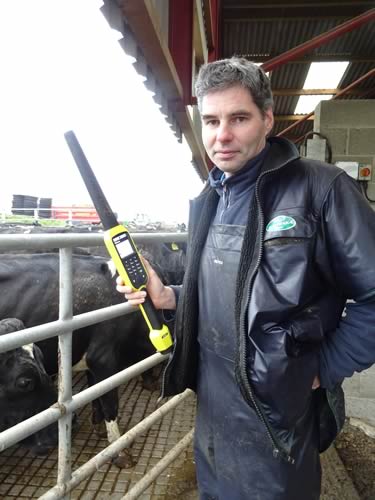| 2018-02-09 |
Weigh Animals Regularly or Risk Going Out of Business
The next three to five years will be all about efficiency – part of which is embracing new technology and ensuring you make the most of all farm data to raise profitability on your unit.
That’s the view of Rob Massey, Managing Director of Tru-Test, a solutions-based business, specialising in weighing, EID and fencing for all farming situations.
Shropshire farmer, Matthew Ingram with the Tru-Test wand he uses on his herd of 500 cows
“It’s a fact that only 10% of UK livestock farmers weigh anything – yet, if you were harvesting grain, you‘d never sell it off the farm without knowing what it weighed,” he says. “The only gauge is the market or abattoir, but by then it’s too late – you’ve missed any opportunity to get it right.
“When you have a worm burden, lameness, mastitis or any disease issue you’ll see a dip in growth rates. But, if you aren’t monitoring them, and you’re just guessing weights, there’s room for a huge margin of error.”
Rob says the days of writing data in the dust of a tractor, or on the back of a fag packet, should be long gone. “Data is king. It should drive every aspect of your farm business. We have the tools to become more efficient, we just aren’t using them properly.”
He says he’s seen examples of farmers asked to ‘guess’ the weight of a live animal at a demonstration, and that with dairy and beef cattle they can be up to 200kgs out. “No other business would not measure output. Dairy farmers know what milk they are sending off farm, but liveweight gain is another matter altogether.
“I don’t understand this reluctance to embrace technology. I think a lot of it is tradition – ‘my grandfather or my father’ always did it this way. We’re not mathematicians so we have calculators – and in this case, there shouldn’t be a farm without an ability to weigh the stock.”
Rob accepts there is a massive issue with wormer resistance, for example, and says giving the right dosage – which is based on weight – is one of the key reasons behind this.
“You don’t have to buy top end products, honestly anything is better than nothing. A measuring stick or a weigh tape are not exact science, but better to use either of these than your eye.”
He says you will get back any money invested in weighing equipment inside a year. You’ll save money on inputs such as wormers and vaccinations, and will get heifers back on track bulling and calving at the right weights.
“The average calving age is 28 months at best, with a calving index average over 400 when it should be 365. These ‘losses’ represent huge costs to a dairy farm, and using the right technology can so easily improve margins.”
There needs to be a ‘mindset change’ with producers embracing new technology, regardless of their farming system. “They should be asking ‘what does it save’ not ‘what does it cost’,” he adds.
Looking ahead, he says the majority of farmers are waiting for EID to become compulsory, rather than considering the savings it can offer.
“It can offer huge cost savings,” he says. “Just one kg of liveweight gain over an animal’s lifetime will increase returns by £1.50 to £2 a beast. It’s a ridiculously small amount of cost when you consider what it will give you back.
“This isn’t about saying that farmers aren’t good at judging the weight of their animals, it’s about making their life easier, and ensuring they use the latest technology to best effect. Make life easier by investing in the future, so you make the right, and accurate, business decisions.”


